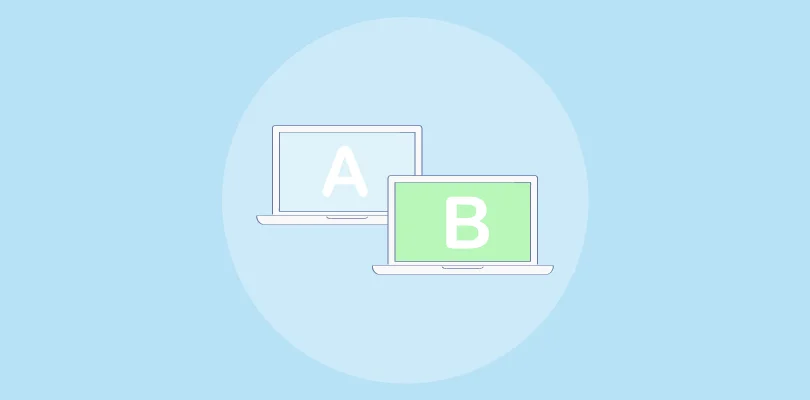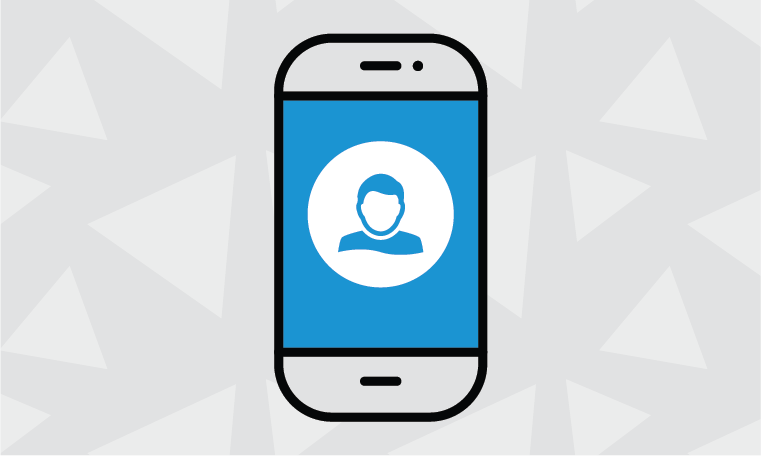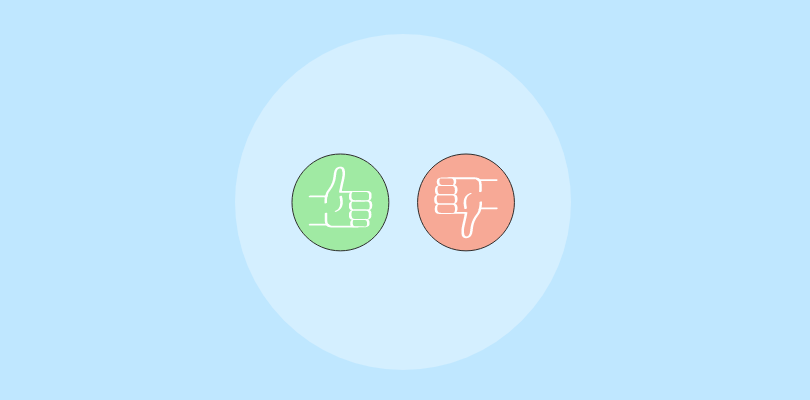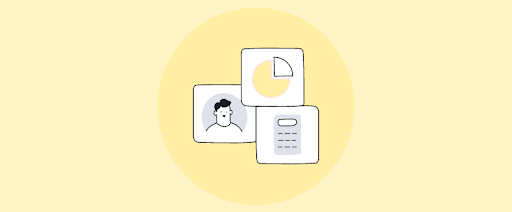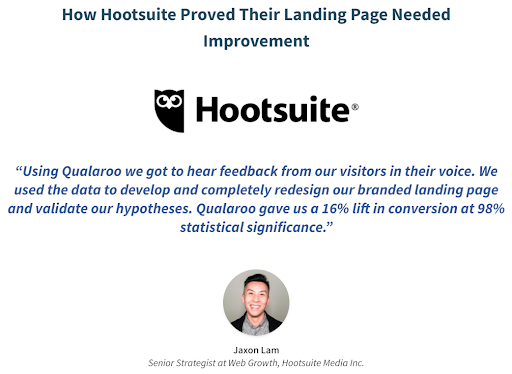Think back to the last time you completed an online customer survey. You probably filled it out, never heard back from anyone, and forgot about it.
That’s a wasted opportunity for the company and a common mistake many businesses make.
How?
A single follow-up email can dramatically increase the response rate. It means you can target both types of customers:
- The ones who didn’t respond to your first touch point so you can remind them of the pending survey.
- The ones who submitted the response so you can ask some follow-up questions.
But most companies rarely capitalize on this strategy.
97% of companies don’t even send a single follow-up email after offering their customer service.
Imagine the state of the customer success strategy if such numbers prevail in other business areas.
So, since many companies don’t follow up with customers, sending a personalized follow-up email gives you a huge chance to differentiate your company from your competitors.
You’ll surprise and delight your customers by showing them you care — not just about hearing their voices but also understanding them.
So, let’s take it from the top and understand what follow-up surveys are and how you can leverage them to increase response rates, collect targeted feedback, and gauge customer experience.
What is a Follow-Up Survey?
As the name suggests, a follow-up survey is a questionnaire you send via email to follow up on a customer or prospect for different reasons.
For example:
- When they have contacted your company to avail your services/products.
- When they reach out to your support services.
- Once the customer starts using the product.
- When you are trying to bring back a churned customer.
These follow-up surveys also allow businesses to collect contextual feedback from customers who give low ratings on the survey.
Types of Survey Follow-Ups
Businesses use follow-up surveys for various reasons. The content of the mail would depend on the action or information you desire from the respondent.
So, here are a few types of most commonly used follow-up surveys:
- Survey Reminder Follow-Up
Reminder follow-ups are emails sent to customers to remind them about a pending survey, an abandoned cart, etc.
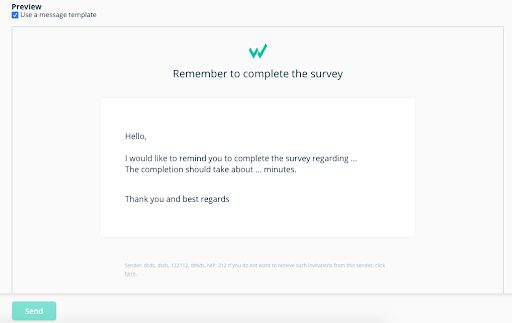
These are useful for improving the response rates of your survey campaigns and quickly achieving the required sample size.
- Investigative Follow-Up Survey
Investigative follow-ups are where companies send surveys to their customers to gather more information about their experience with the brand.
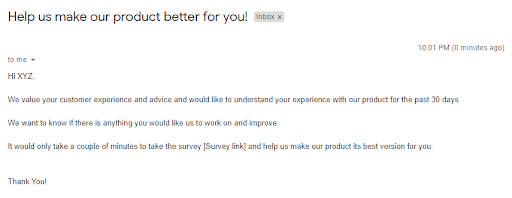
For example:
- When a customer buys a product from your website, you can send a follow-up survey after 30 days to collect feedback about the product experience.
- If a customer opts out of your services, you can send a follow-up survey to discover the reason behind their decision. Then, use the data to convince them to come back and improve your product.
Acknowledgment Follow-UpSurvey
Businesses often send emails to thank customers for their purchases and add a survey to gather feedback about the shopping experience.
In other cases, you can combine acknowledgment emails with investigative surveys to collect valuable insights.
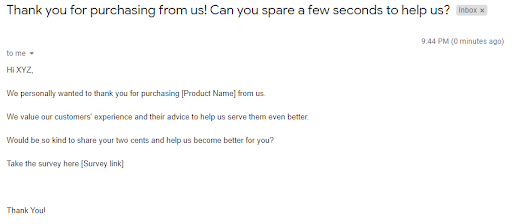
For example, suppose a customer raises a support ticket or complaint. You can send an acknowledgment and add some follow-up questions (investigative follow-up) to get more in-depth information about their issues or concerns.
Post-Resolution Follow-UpSurvey
If a customer has raised a complaint, it is necessary to know whether they are satisfied with the provided resolution. That’s where a post-resolution follow-up survey comes in handy.
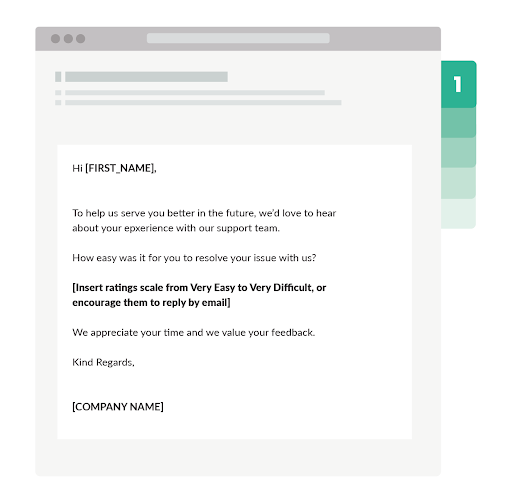
It helps gather feedback on how easy or difficult it was to resolve their issues and if they are satisfied with the support received.
What are the Benefits of Follow-Up Survey Emails?
Before discussing how to follow up on respondents, we believe it’s important to know why you should follow up at all. So, here are a few benefits of following up via surveys.
1. Boosts Sales and Conversions
A great recipe for satisfied customers is to ask them:
- what they need,
- what things they find problematic, and
- what they enjoy the most about your products/services.
Although it’s best to target visitors on the website or mobile app with pop-up surveys, you can also send a survey through email to follow up.
For example, using feedback software Qualaroo’s identity API call setting lets you capture registered users’ email addresses, usernames, and customer IDs with their survey responses. It makes sending follow-up survey mail much more manageable.
In doing so, you’ll understand what you need to improve to make your customers happy and eventually boost your sales and conversions.
2. Optimize Customer Experience
As a business, you can’t rely solely on your loved products or services; you need to get your hands dirty and explore areas of improvement to offer a flawless customer experience.
You can, of course, go for methods that explore customer behavior more deeply, but simply listening to the voice of your customers goes a long way too.
For this, deploy different surveys on your website, follow up with the respondents to collect more in-depth data, get behind the customer issues, and strategize how to resolve them.
3. Boost Response Rates With Reminders
Not all customers fill out the survey on the first survey request mail. But, this shouldn’t be the end of the line for you.
You can still salvage your attempt using survey reminders.
These follow-up surveys remind people to take your survey. Some customers may forget to take it the first time you sent it to them; some may not want to on the first try but may change their mind later.
So, these reminder emails are like a second chance for customers to share their feedback and for you to improve the response rate.
4. Engage Customers With Your Brand
Customer engagement is crucial for businesses, but it is not easy to do. It’s challenging to find motivating ways to make customers interact with your brand at different touchpoints.
Follow-up survey emails are another interaction point through which you can engage customers.
Using incentives, you can even increase engagement on your surveys and email survey follow-ups. These can include discounts, time-sensitive deals, or access to gated content.
You can also try gamifying your surveys, making them more interactive for customers, and they may engage out of curiosity.
Many brands also use survey polls on their social media, such as Twitter Polls or polls on Instagram Stories, to engage customers and collect quick feedback.
Here’s what they look like:
Twitter Polls
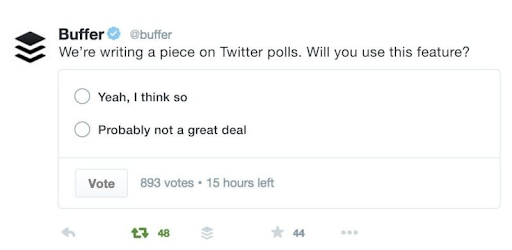
Instagram Polls
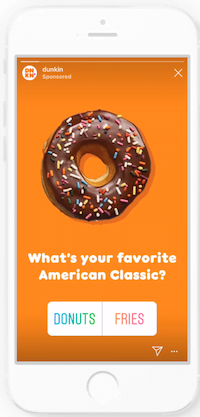
5. Shows Customers That You Care About Their Opinions
Did you know 96% of customers say that customer service is a crucial deciding factor in their loyalty to a brand?
And letting your customers know that you care about them by constantly seeking their feedback on their experience makes for remarkable customer service.
Even as customers, don’t we all want to be regarded as valuable and feel heard? Then it should come as no surprise that’s precisely what your customers expect from you.
Here are a few ways to do it using follow-up surveys:
- Send a follow-up survey after the customer interacts with the support staff.
- Ask them about their experience and how knowledgeable the support agent was.
- Once you close the support ticket or live chat, ask for satisfaction ratings and suggestions on improving the service further.
So, now you know why follow-up feedback survey emails are a big deal for companies worldwide, it’s time to move on to the hows and the whens.
Follow-Up Survey Reminders: How Many & When to Send Them
We know that sooner or later, you’ll wonder when’s the right time to send these follow-up survey reminders and how frequent is too frequent. We’re ready with the answers.
When Is the Best Time to Send Survey Follow-up Emails?
There is a delicate balance between how soon is too soon and vice versa. So, we’ve defined the ideal time to send follow-up survey emails for each survey email type.
These time-frames are based on our experiences. The best way is to start sending the follow-ups and track the response rate at your end. You can make changes to maximize responses.
Here are the different types of follow ups that you can send:
- Survey Reminder Follow-Up
The most effective time frame to follow up on your survey is 42-78 hours after sending the first survey mail.
If you consider this time frame, you won’t:
- Annoy customers who want to participate
- Be so late in following up that respondents forget why you’re approaching them
- Investigative Follow-Up
Investigative follow-up emails aim to collect data about customers’ experiences with your products or services. So customers should be given enough time with product adoption and usage. With this in mind, it’s best to send these follow-ups after 30-60 days of purchase.
- Acknowledgment Follow-Up Survey
The ideal time window for this type of follow-up email can range from a few hours to a day after the customer is sent the first mail.
You can set the priority for different mails to send the acknowledgment follow-up at the right time and collect valuable insights from customers.
- Post-Resolution Follow-Up
Since post-resolution follow-up emails aim to gauge customers’ experience with their support personnel after resolving issues, it’s best to send these emails within a few hours of interaction.
The experience is fresh, so customers will be able to share their genuine feedback in great detail.
Additional Points:
Also, studies show surveys sent on Mondays receive more responses than surveys sent on Fridays.
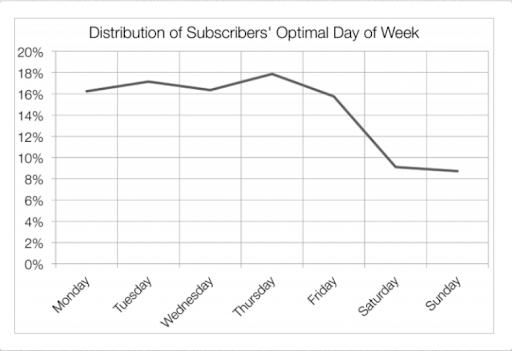
One of the reasons for this is that customers have a whole week to respond if you send surveys on Mondays.
Oh wait, there’s more.
Since your customers come from different industries, the effective time to send survey follow-up emails will vary a little.
For example, 10 AM to 2 PM will work best for most of your subscribers. And customers like hospitality workers, shift workers, nurses, etc., will have a wider time window of 10 AM to 10 PM.
Hilton Hotels, a global hotel chain, sends customer satisfaction surveys to their guests 24 to 48 hours after their visit. They get a majority of the survey responses within 24 hours.
💡 FUN FACT
Hilton Hotels, a global hotel chain, sends customer satisfaction surveys to their guests 24 to 48 hours after their visit. They get a majority of the survey responses within 24 hours.
How Many Survey Reminder Emails Are Too Many?
As much as you’d want to send reminders until your respondents give in, it’s not the best idea. Although the amount of reminders you should send depends on your survey response rate, it’s best to keep the number between 2 to 4 reminder emails.
If you send more than this, your respondents will feel overwhelmed and may not take the survey.
With this out of the way, let’s pull out the big guns.
FREE. All Features. FOREVER!
Try our Forever FREE account with all premium features!
Follow-Up Survey Email: 8 Golden Rules to Remember
If you’ve had no success with your survey follow-up emails, things are about to change for the better. Behold a few practical tips that you can use to optimize your follow-up process and improve the response rate on your surveys.
So, starting from the top – the subject line.
1. Capture Attention with the Subject Line
Did you know that 33% of email recipients open emails only with interesting subject lines? So, if you didn’t realize how impactful subject lines can be, it’s a good thing you ended up with us.
Let’s show you what good and bad headlines look like in follow-up feedback survey emails, so you never send a bad one.
Good subject line for follow-up survey example:

But what’s so powerful about it?
- The subject line immediately catches your attention with words like “discount sitewide” and “2-minute survey.”
- The incentive motivates respondents to take the survey or, at least, open the email.
- It tells exactly how long it will take to complete the survey, so respondents don’t feel discouraged thinking it’ll take a lot of time and effort.
Bad subject line example:

This survey email sample does exactly the opposite of the good subject line. It only asks respondents to take the survey, giving no information or motive for them to open the email.
A report by MailChimp states that using words like “help” or “important” instead of “urgent” reduces the response rate.
So, better steer clear of such words and create subject lines that would motivate you to open the email.
Here are a few sample subject lines you can use for reference:
- Hello [Name], can we talk for 15 seconds?
- Want to win a flat 30% off on your purchase?
- Hi [Name], we would love to talk about [topic]. Can you spare a few seconds?
- Hi [Name], can we talk about [Product name]?
- How would you like to enjoy free delivery for a year?
- Win a gift voucher worth $10 now!
- Your experience matters. Care to share it with us?
2. Embrace Personalization in Your Emails
You already know how prominent personalization has become with today’s marketing efforts.
But if there’s still a speck of doubt, check this out –
Personalizing emails boosts open rate by a staggering 82%, CTR by 75%, and customer satisfaction by 58%!
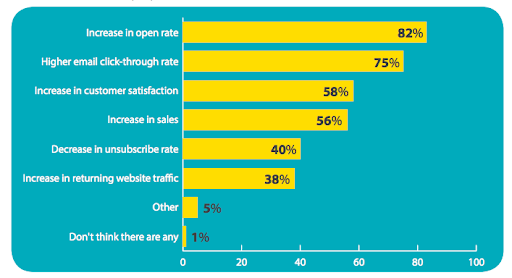
Talk about impressive numbers, huh!
It’s time to get on the email personalization bandwagon.
It shows that you are not sending generic emails to spam them but crafting each email carefully according to their preferences, needs, and wants.
Personalized email follow-ups also give your customers a sense that they matter to your brand.
Here are some ways to do it:
- Mention their name in the subject line and email body.
- Remind them about the concerned interaction to jog their memory when asking them to fill out the survey.
- Follow up after they interact with your support services and then ask them to share their experience.
- Present them with exclusive personalized deals, offers, and access to premium services as a reward.
3. Approach Persistently Without Annoying
As we covered in our different types of survey errors article, one frequent mistake businesses make is crossing the boundary between being motivating and annoying.
Of course, follow-up survey emails need to be persistent and encourage customers to open the email and take the survey.
But trust us, persistence can become an annoyance quickly if you are not careful.
So, we suggest you stick to the recommended number of follow-up emails. The last thing you want is your customer feeling bombarded with unnecessary emails.
4. Emphasize the Importance of Customers’ Opinions
One of the most effective ways to convince customers to take your surveys is to give them a reason, a cause they would be interested in.
For example, Spotify shares why it collects feedback and how it will help the customers.
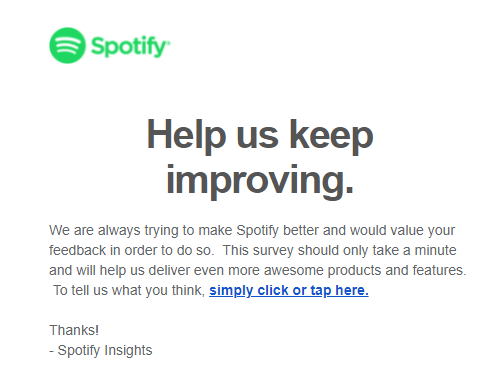
and here’s another interesting example from Blume.
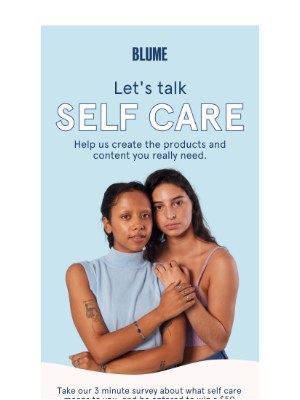
See how they emotionally appeal to customers and emphasize how important feedback is not for just the brand but also the customers themselves.
5. Ensure Customers of Data Security
Customers refrain from participating in surveys when they don’t know what they are in for and how you will use their information.
So, why leave room for skepticism at all?
The best solution to this is to be open about why you are conducting the survey and what you intend to do with customers’ information.
Unlike the previous point, the aim of disclosing your survey’s purpose here is to justify collecting customers’ information and assure them that shared data will be safe.
Here’s an example:
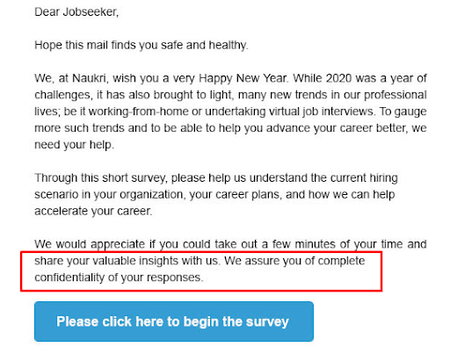
By ensuring that respondents’ data is secure or that their responses are confidential, you immediately put the customers at ease.
Adding trust seals in the survey is another way to go about it and an effective one at that. Customers are more likely to trust you and may consider taking your survey.
Whereas, in the above point, you are giving customers a cause to take the survey by explaining your purpose.
6. Barter Incentives for Surveys
No one wants to do anything for free.
Everything has a price, and your customers are no different. If you want them to take the time to fill your survey without getting anything in return, you’ve wished on a shooting star.
So, what can you do? Incentivize.
For example, here’s what Trello does. After they ask customers to take the survey, they also mention the benefits that respondents will get for their participation.
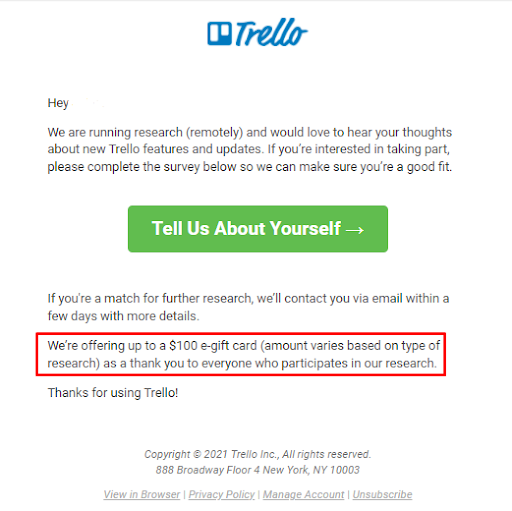
The incentive you offer would depend on your survey type and the depth of information you require from the respondents.
If it’s extensive user or market research, you can give incentives appropriate for the respondent’s effort.
If it’s a small survey about general customer feedback or a product opportunity survey, you can offer a small discount, gift voucher, coupon, etc.
7. Keep the Survey Emails Short and Relevant
Just like your surveys, keep the follow-up emails – short and sweet.
Remember, you are not writing an email to pitch your product/service. You are simply reminding them to take the survey.
Always try to keep the tone of the email conversational and sum it all up in 2 to 3 lines.

As we covered in our different types of survey errors article, one frequent mistake businesses make is crossing the boundary between being motivating and annoying.
Of course, follow-up survey emails need to be persistent and encourage customers to open the email and take the survey.
But trust us, persistence can become an annoyance quickly if you are not careful.
So, we suggest you stick to the recommended number of follow-up emails. The last thing you want is your customer feeling bombarded with unnecessary emails.
8. Provide an Easy Way Out
As a customer, don’t you appreciate it when brands add an “Unsubscribe” option to their emails so you can choose not to be a part of their future campaigns?

That’s what you need to offer to your customers. Give them an easy option to opt out.

Don’t try to make it harder for them to unsubscribe by hiding this option under a multitude of steps.
It will only tamper with the customer experience you worked so hard to build. So, simply add an unsubscribe button or link in the email footer.
As effective as these options are for following up on your survey request emails, you still need something more specific for each type of follow up. For instance, how should you follow up after an NPS survey, a post-purchase survey, or a survey asking for feedback about product features?
Let’s have a look at the answers.
Leveraging Follow-up Surveys: 5 Use Cases
Feedback survey tools like Qualaroo allow you to create engaging, delightful, and simple pop-up surveys that customers don’t mind taking. Be sure to follow up if you think you need more responses.
So, here are a few scenarios where you can take advantage of follow-up survey mail:
1. Engaging Your Prospects
This is the first stage in the customer journey where prospects have just learned about your brand. They may have filled out a lead generation form or signed up for your newsletter.
Now what?
How will you engage these prospects to drive them deep into your sales funnel?
Easy: Follow-up emails!
You can instigate engagement through follow-up mail with the information you’ve collected through the lead generation form or newsletter signup.
You can encourage them to:
- Schedule a demo in case of SaaS products
- Check out some exclusive deals and time-sensitive discounts
- Give them access to gated content
At this point of the customer’s journey, your follow-up email is a tool to get the prospects to take the next step towards becoming paying customers.
2. Onboarding New Customers
At this stage, you’ve successfully turned your prospects into paying customers, and it’s time to give them a lay of the land, i.e., introduce your product.
Of course, you must have implemented an onboarding process to highlight your product’s features and functionalities.
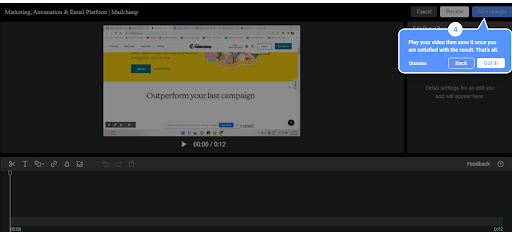
But customers can still have a lot of queries since they are new to your product.
Yes, you can put a knowledge base or a live chat tool in place so your customers can resolve common queries or reach out to you. Still, experience personalization is the best route.
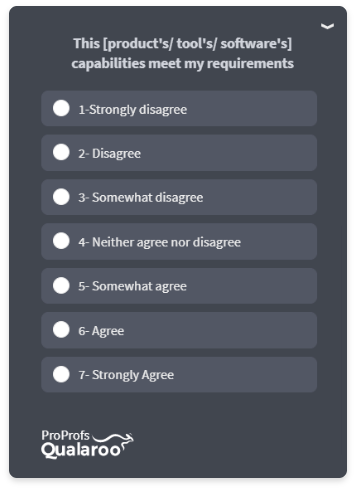
You can send a follow-up email survey as a part of the onboarding process and ask them how they are finding your product and if there are any issues/queries.
3. Collecting Post-Purchase Product Feedback
There are two types of follow-up emails you can send customers after their purchase:
- Ask them what made them buy from you
- Collect feedback on specific features
Let’s discuss each point.
Ask them what made them buy from you:
These surveys uncover why individual customers buy from you with product appeal questions like:
“What persuaded you to purchase from us?”
The answers to these questions help you shape product messaging to differentiate it from competitors.
Also, you can use your follow up to tell respondents that hearing more from them will help you reach new customers. This gives them a slight sense of ownership over your future success.
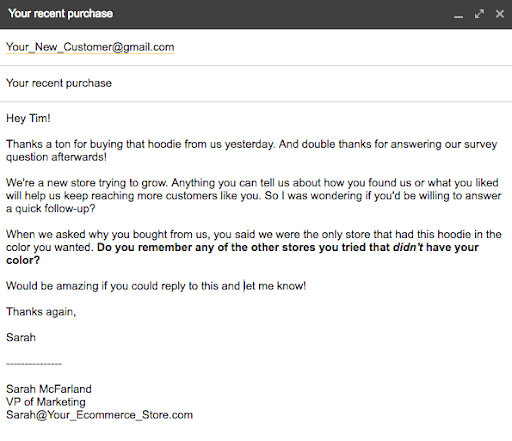
This hypothetical email might not look like much, but it’s clear nature is an advantage. The simplicity leaves no doubt that an actual person wrote it.
More importantly, the sender goes out of her way to say that if the customer answers her question, her company will be able to grow more.
This email taps into that sentiment and gives the customer an easy way to act — all Tim needs to do is reply.
The key is to make them feel so valued that they want to give you more feedback and help you out.
Collect feedback on specific features:
These surveys are more focused on what customers think of specific features. Feature-specific surveys include product feedback questions like, “What’s the one feature we could add to make this product indispensable to you?”
When customers answer such questions, they take the time to think tactically about how those features affect their day-to-day work.
In your follow-up message, you need to understand how your product provides a solution to a specific problem and show customers you care about helping them reach their goals. That way, they know you’re on their side.
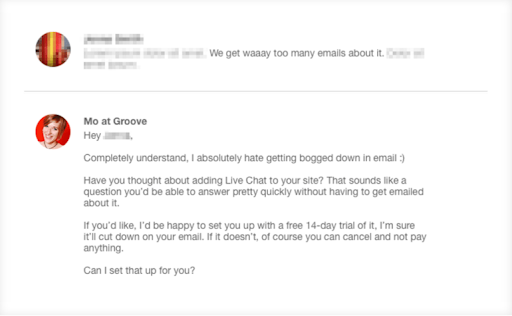
This email exchange comes from customer success, but it perfectly illustrates the customer-centric mentality you need when talking to a survey respondent.
Usually, customers find upselling aggressive and sales-y. But Mo from Groove shows the customer that she’s putting their best interests first by positioning her upselling offer as the exact solution that the customer needs.
When you follow up with respondents on a feature-focused survey, you need to understand the context in which the customer uses your product.
And accordingly, frame the conversation around how you can help them more in that context.
You need to:
Ask questions: If a customer asks for a specific feature, don’t take it at face value. Ask them what they could accomplish for their business with that feature so you can focus on helping them.
Upsell helpfully: Your questions might uncover that the best solution for this customer is to move up to a better package. When you try to convince them, show the customer how it will help them get their desired outcome.
Know what feedback to discount: Sometimes, a suggested feature adds no value to your product. You can choose not to follow up if someone responds to your survey with a feature suggestion that doesn’t make sense for your product.
These tactics set you up for a productive conversation about the small changes that’ll add a ton of value for your customers.
4. Testing Customer Loyalty With Overall Customer Experience
Net Promoter Score (NPS) is the prime example of a survey that uncovers your product’s overall value to the customers.
Customers who fill out NPS surveys offer you vital information, essentially telling you if your product is viable for your target market. That alone is enough reason to get in touch and learn more.
You can also deepen the relationship by going out of your way to show them that your company appreciates their feedback, takes it seriously, and uses it to improve products/services.
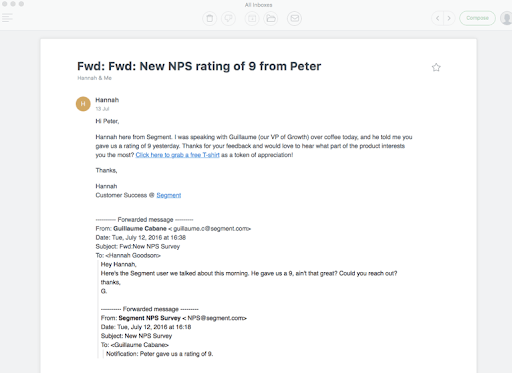
This customer, Peter, gave analytics provider Segment a 9 on an NPS survey but didn’t tell them why. Instead of patting themselves on the back and accepting the high score, Segment contacted him to get the context behind it.
The crucial part of this email is that Segment offered Peter a free t-shirt regardless of whether or not he would give them additional feedback.
By giving him the gift for free, Segment made Peter more likely to respond to the email by tapping into the reciprocity principle.
Segment’s email gives us three essential tips for following up with NPS respondents:
- Offer a free reward: Gifts get you a lot more than bribes.
- Keep it conversational: Customers don’t want to hear industry jargon or long-winded explanations. So, Segment kept its email to two short sentences and used casual vernacular to assure the reader that a person wrote this email.
- Tell them how important the feedback is: Segment accomplished this by including its internal email chain with the VP of Growth discussing Peter’s rating. That shows Peter what a big deal his feedback is to them.
You can use these same tactics to win back loyalty from NPS detractors. Just strike a more pacifying tone in the email as you ask for more feedback.
5. Listening to Churned Customers
Not all customers will renew their subscription or repurchase your product. Customer churn is a hard reality every business faces.
But is there really nothing you can do once your customers churn?
Not necessarily. You can send a follow-up survey to the churned customers to understand what ticked them off and made them leave.
Not all customers may respond, but some are still better than nothing. With these follow-up survey emails, you can discover the cause of churn and improve on those fronts.
You can even follow up on this email and inform them of the solutions you’ve implemented to resolve their problems. Doing so may encourage them to give your product/service another try.
What to Do After Sending the Follow-up Survey Mail?
Now that you know how to make the most out of your follow-up survey emails, you should also know what to do next. The process doesn’t end with just sending reminders, right?
Here are a few tips you can refer to:
Create an A-Team to Take Actions
Although it’s best to do this before launching your surveys, you can do it afterward. Create a team of a few people from influential positions and different departments.
They’ll look into the feedback data and create strategies to incorporate the insights you worked so hard to get. In the end, if you don’t use that data to do something, whatever you have done up until this point is futile.
Address Key Areas
This is where the team you created would spring into action. Here are a few key areas this team can take care of to streamline the process:
- Review the survey before sending it to customers to catch any errors and ensure that the questions are relevant and to the point.
- Review the feedback data regularly, say weekly or twice a month.
- Create brief yet insightful reports from the data to build different customer experience and success teams.
- Create a roadmap to work on the issues highlighted in the feedback and achieve the set goals.
Pay What You Promised
Always make sure to fulfill your promises made to customers. If you offered incentives to respondents before they took the survey, make sure they get the promised incentives on time.
If not, it’ll only frustrate them, and you may not just lose a respondent to your next survey campaign, but a valuable customer altogether.
Define KPIs Based on Your Survey
Define relevant metrics and key performance indicators to track how the feedback has helped your business.
For example, if your current NPS score is 52, then set a goal to increase the score to 60 in the next nine months using the feedback data from your surveys.
Increase Survey Responses With Your Follow-up Surveys
As long as you target the right users, ask simple questions, and deploy follow-up survey emails at the right time, you’ll get enough responses to gather meaningful data, especially while using online survey software.
As discussed earlier, following up with customers at different stages of the customer journey is a great way to boost engagement, response rate, conversions, and overall experience.
In the same way, personalizing the follow-up survey emails is even more effective in procuring valuable insights and building respondents’ commitment to your brand.
Why?
It’s very simple! If you treat your customers like people, you’ll get business insights and deeper customer relationships.
 Tips
Tips
We’d love to hear your tips & suggestions on this article!
FREE. All Features. FOREVER!
Try our Forever FREE account with all premium features!
 We'd love your feedback!
We'd love your feedback! Thanks for your feedback!
Thanks for your feedback!


